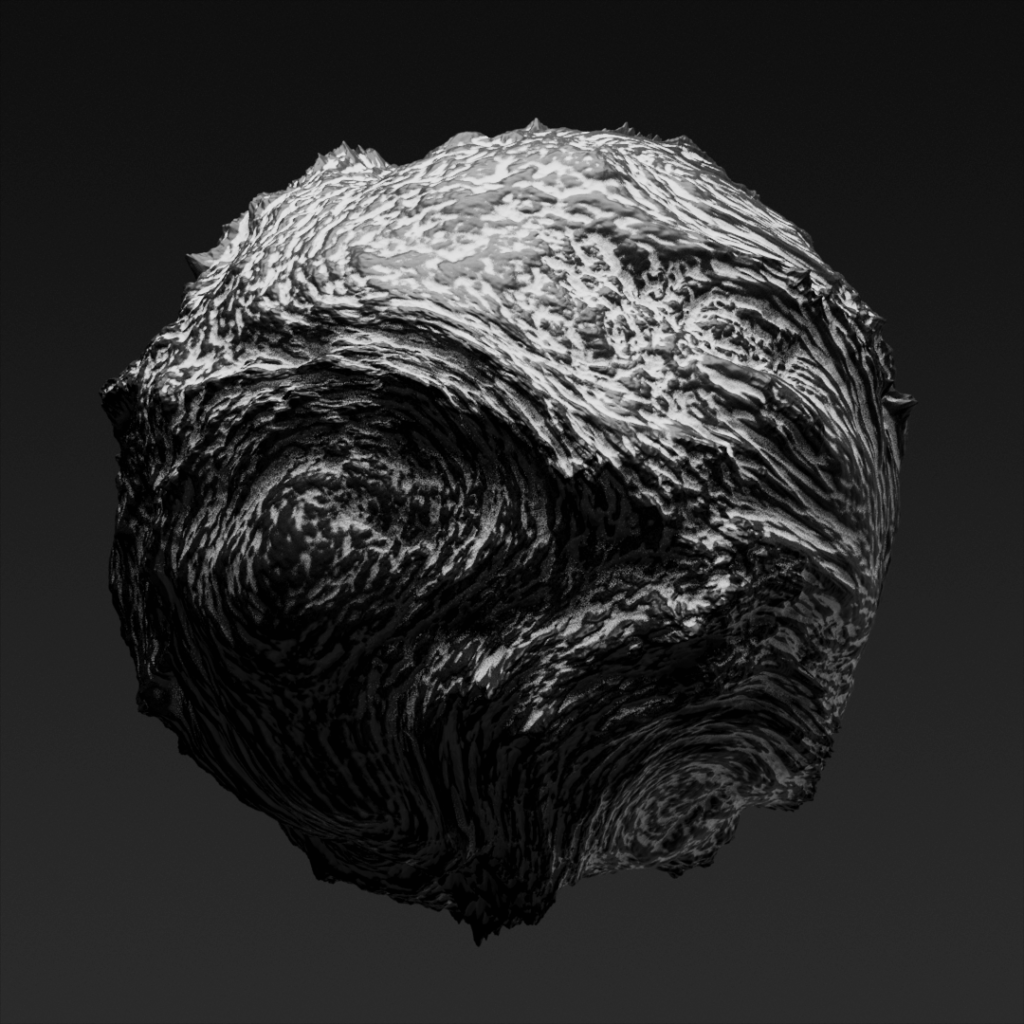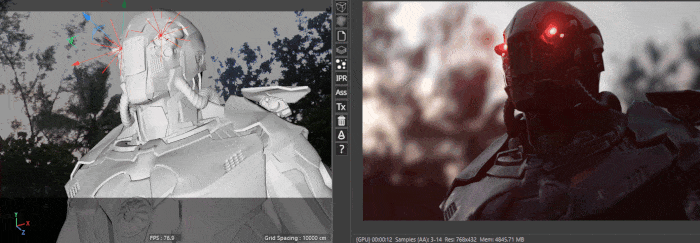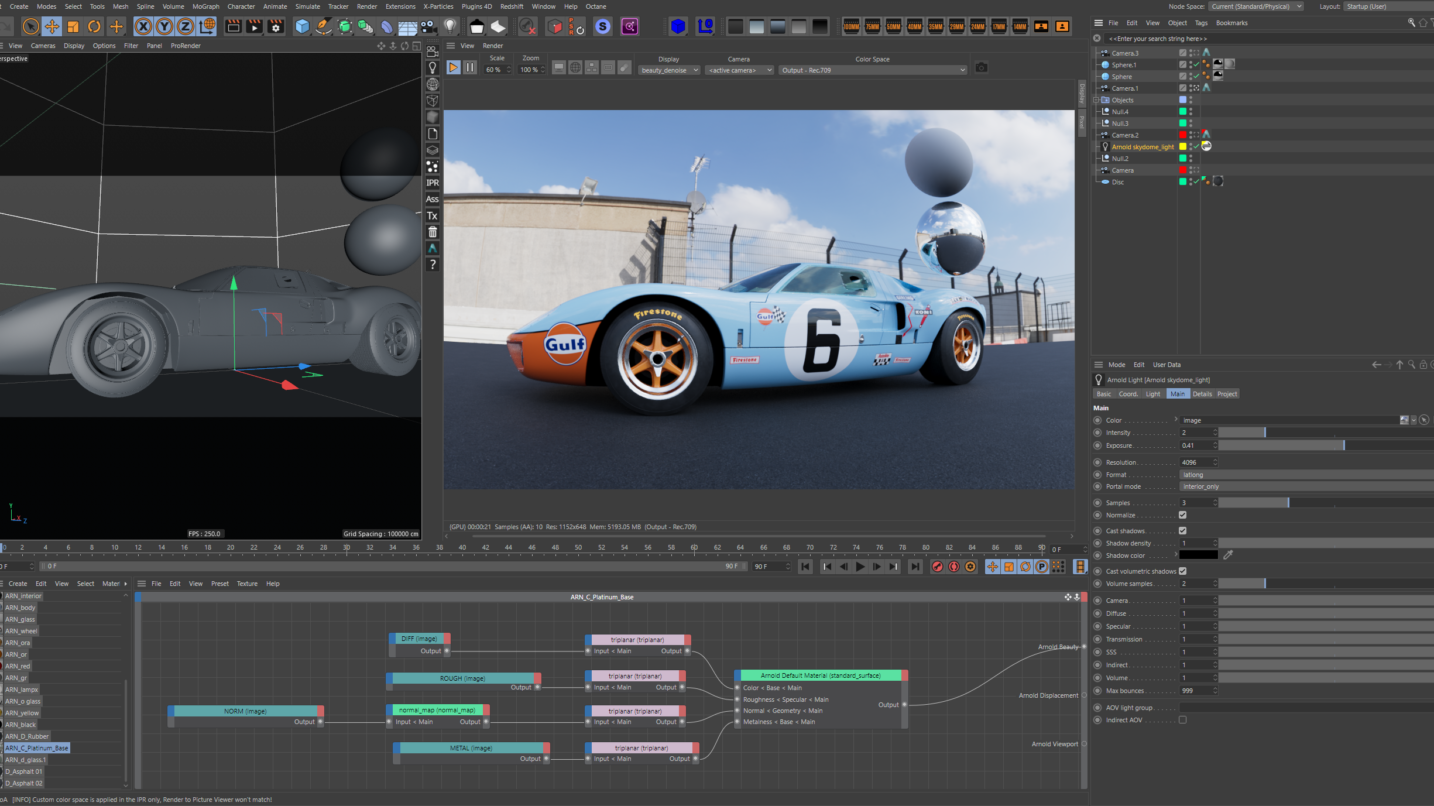
With the latest release, Autodesk’s Arnold renderer becomes the most versatile C4D render engine that works on both CPU and GPU.
One of the most asked questions Greyscalegorilla receives is which render engine to use. It’s still not a simple answer, but for the first time, we can definitely recommend one based on versatility + features.

Autodesk Arnold is one of the leading Cinema 4D render engines that can be used by both Mac and PC artists, and now that the NVIDIA GPU version is fully released it’s incredibly powerful.
Arnold 6 is not the most feature-rich new release, but it doesn’t really have to be.
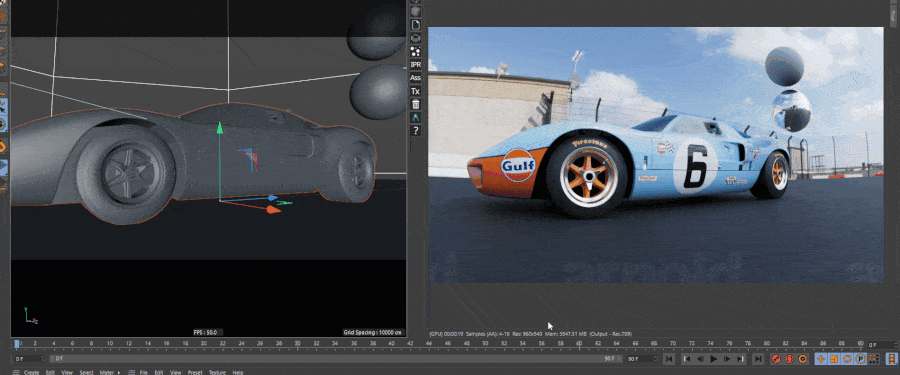
The removal of the word BETA from it’s GPU offering could be called premature (and I wouldn’t necessarily argue with them), but there is no denying the power of being able to flip from CPU to GPU. The new licensing methods are also a welcome change to the old, overly complicated system that required a degree in IT to get up and running (though still has tons of room for improvement).
Let’s dive into the latest release, and really take a look at things.
Overall Benefits to Arnold 6:
- Easy to Use
- Most versatile renderer for both Mac and PC (CPU + GPU), though GPU is not supported on Mac
- Works across all major DCC’s including Cinema, Houdini, Maya, and Max
- Most feature-rich renderer (including a full Toon System)
- Supports more native C4D features than most current renderers (Noises, Background Object, Floor Object, etc)
- Extremely stable
- Memory Efficient
- Affordable Single Seat Licenses
- Monthly subscriptions available
- No watermark restrictions – You can work on the watermarked version with no feature limitations
- Extremely responsive IPR in both CPU/GPU
- Supports industry standards like OCIO+ACES, OSL
5 Must-Know Things About Arnold 6
- Arnold GPU:
- Out of Beta
- More Stable
- Supporting nearly every feature of CPU (including light filters, LPE’s, and nearly all AOVs)
- No Mac Support
- Lower Pricing Structure
- New Arnold license process – Somewhat easier to get up and running, and cheaper options.
- A ton of bug fixes. Stability matters in production.
- Quality of life updates (node alignment tools, material exports, etc)
Thoughts on Arnold GPU
Arnold GPU was no small feat. Taking a production-proven CPU renderer and pushing it to deliver 1:1 results on the GPU is very difficult. Renderman is currently working on XPU which promises to harness the power of your CPU and GPU simultaneously, but it’s proved challenging to bring to market. We believe the future is about leveraging ALL your hardware. Power and flexibility will always win out. Arnold being able to give 1:1 results on both CPU and GPU is incredibly compelling.
If I were starting a small studio right now, I would be using Arnold GPU on my artists’ workstations to do look dev/lighting and then switching to CPU mode to throw to an inexpensive cloud render farm solution such as Pixel Plow. I’d outfit every 3D workstation with dual 2080ti’s and a Threadripper to give every artist the flexibility to use whichever mode better suits their work. What a time to be alive!

Now I’ve been on the beta for Arnold GPU since it opened over a year ago. I’ve watched it slowly go from a buggy, noisy mess into something I actually use on a daily basis.
The first question anyone ever asks me is whether or not it’s faster than it’s competitor Redshift. My answer is always the same, mostly no. In my testing, Arnold GPU is 10-20% slower than Redshift on most tasks. However, in some cases, it can close that gap very nicely (usually on scenes with tons of GI bounces).
Even with Redshift besting it in terms of sheer speed (as one would expect from a biased GPU renderer), it cannot touch Arnold in terms of features and user experience. Arnold outshines its competitors with production proven features and a Cinema 4D plugin that is easily best in class.
I’m also a bit spoiled as I use Arnold with a 64-core AMD Threadripper. So Arnold CPU for me is certainly no slouch. In fact, only now with Arnold 6 can I say that their GPU offering is giving my beast of a CPU a run for it’s money.
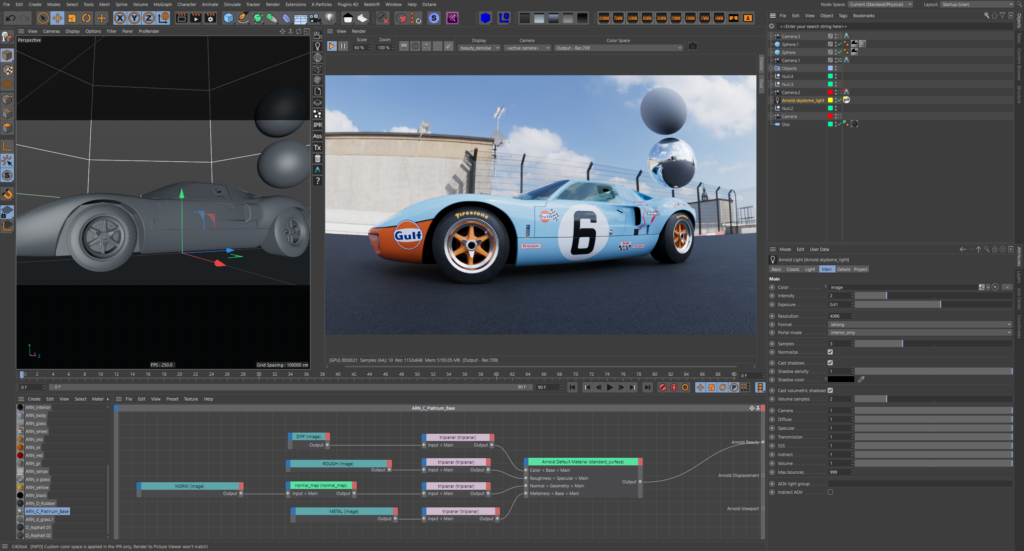
Should I switch to Arnold GPU?
Well, there are a few things to consider
- Arnold GPU is Windows only, sorry no Mac support at this time
- Arnold GPU is Nvidia ONLY and more cards the better. I HIGHLY recommend RTX cards as Arnold GPU is optimized for that platform. I’ve got two 2080ti’s and I wish I had more!
- Arnold GPU takes advantage of NVLink (an $80 device that links multiple RTX cards together) and in my opinion, is a MUST HAVE if you want to maximize speed in Arnold GPU.
- You also have to be “OK” with Arnold GPU taking a bit longer to render than it’s competition, but in exchange you get superior features and first-in-class plugin experience. Plus, you can always design in GPU and send to a CPU farm. Versatility!

What are the Key New Features of Arnold 6?
- Faster creased subdivs: Hard creases are now fully supported in adaptive and multithreaded mode. This means creased surfaces will use all procs during subdivision.
- Dielectric microfacet multiple scattering: Rough dielectrics are now energy-preserving by accounting for multiple scattering between microfacets for both reflection and refraction, avoiding the energy loss of the previous implementation. Disabling the global option enable_microfacet_multiscatter will restore the previous look.
- Physical Sky shader improvements: The physical sky shader will now extend the color at the horizon all the way down to the bottom pole.
- Improved roughness mapping of the Oren-Nayar diffuse BRDF: The Oren-Nayar roughness parameter has been remapped so that values close to 1 no longer result in excessive darkening. This change also improves the Standard Surface and Car Paint shaders.
- Improved rough thin-wall transmission in Standard Surface shader: Refractions in thin-walled mode now appear blurry with non-zero roughness.
- OCIO roles: Roles can now be listed with the color manager API by querying color spaces available in the Role (OCIO) family. This makes it possible to build UIs that list all known roles.
- Skip RGBA denoising: Noise now accepts -ignore_rgba or -irgba to skip denoising of RGBA even if it’s present.
- OpenImageIO 2.1.4: OIIO support is now upgraded to 2.1.4.
- More accurate albedo AOVs: Albedo AOVs now correspond more closely to the true albedos of the material’s BSDFs.
- New AOV Write Vector shader: This enables the writing of vector values into a typed AOV, for example for recording positional values. These would previously have been clamped when using typed AOVs

C4DtoA Plugin Enhancements
- Material export/import: Materials can be exported to ASS files and MaterialX files (.mtlx) via the C4DtoA > Utilities > Material > Export to ASS… menu item or via the Alt~W+X shortcut in the Material Manager. Materials can be imported via the C4DtoA > Utilities > Material > Import from ASS… menu item or Alt~W+I shortcut. Selected shaders from a material can also be exported from the network editor.
- Align nodes in the network editor: New Edit > Align nodes menu item and Alt~W+L shortcut is added to the network editor to align graph nodes in the layout.
- Notification when no license found or license will expire: Now a message is displayed in the render settings when no Arnold license found or two weeks before the license expires.
- New Licensing menu: Licensing menu moved to C4DtoA > Licensing with menu items to open the new Arnold License Manager, help and purchase pages. Note that single-user licensing is not available for testing.
- Added
aov_write_vectorshader - Add Details and Project tabs to Arnold Sky: ****Light filters, user options and light linking settings are moved to these new tabs to be consistent with other lights.
- Flush Caches menu moved under Utilities
Want to learn more?
Check out the C4DtoA 3.0.1 documentation and Arnold 6 overview.

Jumpstart Your Arnold Journey
Your All-Access Pass to the Arnold and Cinema 4D Training You Need
Join Plus